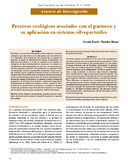| dc.contributor.author | Rush, Graciela M. | |
| dc.contributor.author | Skarpe, Christina | |
| dc.date.accessioned | 2015-03-19T22:03:22Z | |
| dc.date.available | 2015-03-19T22:03:22Z | |
| dc.date.issued | 2009 | |
| dc.identifier | 473909 | es_ES |
| dc.identifier.issn | 1022-7482 | es_ES |
| dc.identifier.uri | https://repositorio.catie.ac.cr/handle/11554/6709 | |
| dc.description | 1 lustración, 1 tabla | es_ES |
| dc.description.abstract | El trabajo es una revisión bibliográfica sobre los factores y procesos ecológicos que intervienen en la interacción entre los herbívoros y la vegetación. Esta interacción está definida por el régimen de pastoreo (el grado de selectividad del forraje, la frecuencia y la intensidad de pastoreo) y el tipo de respuestas de las plantas. Se distinguen dos tipos fundamentales de respuestas. Las primeras se manifiestan en alta disponibilidad de recursos y se caracterizan por una alta capacidad de rebrote y de crecimiento. Las segundas se dan en sitios pobres: donde la capacidad de crecimiento es baja y presentan atributos que les confieren resistencia contra la herbivoría y el desgaste físico. Estas diferencias en respuestas tienen consecuencias sobre la productividad primaria neta y las tasas de mineralización de la materia orgánica. | es_ES |
| dc.description.abstract | The study consists of a literature review about the ecological factors and processes involved in plant-herbivore interactions. These interactions are determined by the grazing regime, (i.e., the degree of forage selectivity and the frequency and intensity of grazing) and by the type of plant response to herbivory. Two fundamental types of responses can be distinguished. The first is appears where there is high availability of resources high resource availability and is characterized by high re-sprouting and growth capacity. The second, in resource-poor environments, have low growth rates and present defense attributes against herbivory and physical damage. These differences in responses have consequences on the net primary production and on rates of organic matter decomposition. | en_EN |
| dc.format.mimetype | pdf | |
| dc.language.iso | es | es_ES |
| dc.publisher | CATIE, Turrialba (Costa Rica) | es_ES |
| dc.relation.ispartof | Agroforestería en las Américas , número 47 (2009), páginas 12-19 | |
| dc.rights | info:eu-repo/semantics/openAccess | es_ES |
| dc.rights.uri | https://creativecommons.org/licenses/by-nc-nd/4.0/ | |
| dc.subject | PASTOREO | es_ES |
| dc.subject | PASTOREO ROTACIONAL | es_ES |
| dc.subject | INTENSIDAD DE PASTOREO | es_ES |
| dc.subject | ECOLOGIA | es_ES |
| dc.subject | FACTORES AMBIENTALES | es_ES |
| dc.subject | RELACIONES PLANTA ANIMAL | es_ES |
| dc.subject | HERBIVOROS | es_ES |
| dc.subject | RESPUESTA DE LA PLANTA | es_ES |
| dc.subject | ALIMENTACION DE LOS ANIMALES | es_ES |
| dc.title | Procesos ecológicos asociados con el pastoreo y su aplicación en sistemas silvopastoriles | es_ES |
| dc.title.alternative | Ecological processes associated with grazing and their relation to silvopastoral systems | es_ES |
| dc.type | Artículo | es_ES |
| dc.journal.issueNumber | 47 | |
| dc.journal.pages | 12/19/21 | |



